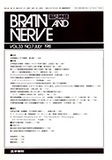Japanese
English
- 有料閲覧
- Abstract 文献概要
- 1ページ目 Look Inside
I.はじめに
ヒトのesthesioneuroblastorna (olfactory neurobla—stoma)は鼻腔に発生する稀な神経原性腫瘍である。この型の腫瘍はBergerら2,3)(1924,1926)によつて初めて記載され,その後,電顕的,組織化学的検索によつて腫瘍構成細胞にニューロンの性格が確認されている1,4,11,15,20,23,24)。Herrold and Duhham8)は1963年,ハムスターにdiethylnitrosamineを投与し,気管,気管支,肝,腎の腫瘍のほかに鼻腔(ethmoturbinal)にも腫瘍が形成されることを報告した。1964年Herrold9)は鼻腔に発生した腫瘍を詳細に検討し,腺癌,乳頭腫,扁平上皮癌のほかにヒトの神経原性の鼻腔腫瘍に組織学的に類似する腫瘍型の存在することを指摘し,olfactory neuroepithelial tumorsとして記載した。Thomas(1965)22)もDruckreyら5)によつてdinitrosopiperadineなどのニトロソ化合物によつて誘発されたラット鼻腔腫瘍を組織学的に検討し,神経原性腫瘍の存在を認め,esthesioneuroblastoma,neuroblastomaと診断している。その後の実験的鼻腔腫瘍の研究では神経上皮腫または神経芽細胞腫の存在を支持するものもあり13,16,18),また疑問を持つ研究者もある17)。癌原性ニトロソ化合物誘発の鼻腔腫瘍にニューロン系腫瘍が認められるとすれば,実験モデルとしてolfactory neuroblastomaの形態発生に関する知見が期待される。
Seventy adult rats of Donryu strain of both sexes were given subcutaneously with 10mg per kg of body weight of N-nitrosopiperidine twice a week for periods up to 10 months. A total of 33 tumors were produced in 32 of 57 animals that survived the treatment more than 241 days. Of 33 tumors 32 were produced in the nasal cavity and 1 in the subcutis around the orbit. The total dose of nitro-sopiperidine for the production of each tumor varied from 165 to 320mg. The tumors arising from the nasal cavity frequently extended into the cranial cavity to replace the olfactory bulbs.
Microscopically, the tumors of the nasal cavity were classified into two groups ; squamous epithe-lioma and undifferentiated carcinoma. Tumors classified as undifferentiated carcinoma amounted 30, comprising 93.5% of the total. They were composed of closely packed anaplastic columnar or polyhedral cells forming compact sheets. Deli-cate vasculo-connective tissue septa separated the tumor into lobules. In some tumors cells produced papillary formations. The cytoplasm of the neo-plastic cells appeared relatively abundant. Rosette-like or glandular structures were often formed in the neoplasms. The lumina contained materials giving a positive reaction for mucin. Bielschowsky silver impregnation method failed to demonstrate argentaffine fibers between the neoplastic cells. Immunohistochemical studies with antibodies to S-100 and GFA proteins were carried out on some tumors. None of the tumors was found to contain fluorescent or immunoperoxidase-positive neoplastic cells.
Histological examinations on the nasal epithelium of the animals with no development of grossly visible tumors disclosed focal squamous metaplasia and foci of hyperplasia of anaplastic columnar cells with frequent formation of gland-like structures. In some animals tumors of microscopic size wereformed with the histology of cholesteatoma or undifferentiated carcinoma.
Twenty-two tumors with the histology of undif-ferentiated carcinoma were studied with a electron microscope. The neoplastic cells were generally arranged in close contact with occasional desmoso-mal connections. A sheet of cells was separated from vasculo-connective stroma by a basement membrane. Most of the cells appeared undifferen-tiated, but richness in smooth endoplasmic reticu-lum was one of the cytological characteristics. Six tumors had evidences of glandular differentiation. Free surfaces of neoplastic cells facing gland-like spaces demonstrated microvilli and occasional kinetocilia with a configuration of 9+2, having nine peripheral doblets of microtubules with an axial complex. Adjacent cells were related to each other apically by junctional devices. In some tumors membrane-bound dense bodies of varying size were found in the cytoplasm of the neoplastic cells, some of which appeared as dense cored granules. They measured from 90 to 260nm in diameter. Neuritic processes containing an admix-ture of microtubules and microfilaments were not recognized between the cells.
The olfactory and rispiratory epithelia of the nasal cavity were also electron microscopically observed in rats to search for the possible cells of the nasal neoplasms induced by treatment with N-nitrosopiperidine.
From these observations it was considered that cells constituting the undifferentiated carcinoma originated mostly from sustentacular cells of ol-factory and nonolfactory epithelia in nasal cavity. Evidences were not apparent for tumor origin from olfactory cells.

Copyright © 1981, Igaku-Shoin Ltd. All rights reserved.


